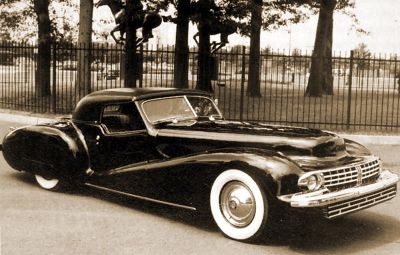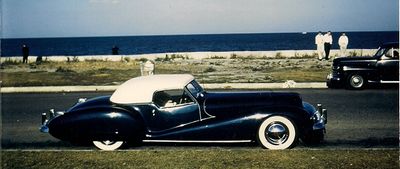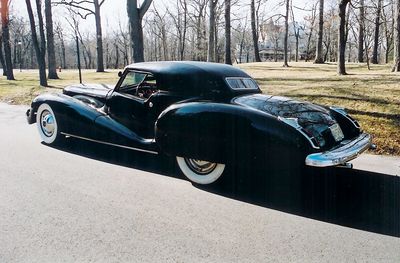Albert Fitzpatrick's 1940 Packard Custom - The Fitzpatrick Special
Albert Fitzpatrick's 1940 Packard Sport Custom, commonly known as the Fitzpatrick Special, is a custom-built car that is significant in the history of post-war custom car culture. Designed and built by Phil Lacey in the late 1940s, the unique Packard is notable for its sweeping fadeaway fenders, chopped-down doors, and the sleek, aerodynamic lines that set it apart from the more common design trends of the time.
Contents
Background and Design Philosophy
After World War II, many custom car enthusiasts in California, including Phil Lacey, began to question the design norms of the era's automobiles. According to Lacey, his interest in customizing cars began in this period when he noticed how large and high the cars were and how much space was under the hood. In 2006, during an interview with Dream Car Garage, Lacey stated, "Why are these cars so big so high? Why not Chop them down? Why all that space under the hood? Why a city on top of a chassis?" His vision was to lower the cars and create a more streamlined appearance, which led to the development of the Fitzpatrick Special.
Lacey drew up several designs during this period, but the Fitzpatrick Special was the only one featuring the now-iconic sweeping fenders. As he explained in 2006, "We drew up several cars; this was only one of about five or six that I drew up, and this is the only one with those sweeping fenders on it. And if I knew how hard they were to make, I don't think I would have even shown that to anybody." The car's design required an incredible amount of skill, particularly to achieve the symmetrical lines on both sides of the car by hand, which left modern designers in awe. "Other people that see the car—today's designers—they ask me, how did he get the symmetry from one side to the other all by hand? And nobody can believe it, but it's true," Lacey added.
Features and Practicality
The Fitzpatrick Special is well known for its cut-down doors, a design element that some have compared to the Packard Darrin. However, Lacey clarified that this was not intended as a mere copy but for practical reasons. "The cut-down doors—people said that's the Darrin Packard, and it was, but the main reason for it wasn't to copy Darrin Packard. So when you drive it, your elbow can sit on the door just right to hold the wheel and drive that way," he mentioned. Designed and built in sunny California, the car was optimized for driving with the top down and the windows open, aligning with the laid-back, outdoor driving culture of the state. The car was only 36 inches high from ground to top and featured hand-formed body panels, a stylized grille, and front and rear flared fenders molded around a 122-inch Packard chassis. Doors, deck, and hood were all operated by pushbuttons. The interior was made of soft, durable calfskin, bleached white to contrast with the blue-metallic exterior. The car took three years and $20000 to complete.[2] The build was completed in 1949.
Impact of the Korean War and Lacey's Departure
Just as the car was nearing completion, the Korean War began to escalate, which significantly impacted Lacey's involvement with the vehicle. He received a notice to report for active duty, which forced him to leave the car in the hands of Albert Fitzpatrick of Fitzpatrick Coachworks in Hollywood, California, who had financed the project. Reflecting on this moment, Lacey recounted, "Just about the time the car was finished, the Korean war was getting warmer, and I got a notice and said, report for active duty. And so I just had to leave the car alone with Fitzpatrick."
During the war, Lacey was sent to Korea and later transferred to Texas. After his military service, he never saw the car again. "After I came back from Korea, they shipped me to Texas, and I never saw the car after I got back. I had no idea that the car still existed," Lacey recalled in 2006.
Legacy
The Fitzpatrick Special remains an important example of early custom car craftsmanship. It stands as a testament to the creativity and ingenuity of post-war customizers who pushed the boundaries of automotive design. Phil Lacey's work on the Fitzpatrick Special is remembered for its distinctive lines, practical modifications, and the challenges it overcame in its creation. The car still captures the imagination of those who appreciate the artistry and labor that went into crafting such a unique piece of automotive history. In 2024, the old custom was owned by custom and concept car collector Joe Bortz.[3]
Magazine Features
Trend Book 101 Custom Cars
Autoweek September 2006
References
Did you enjoy this article?
Kustomrama is an encyclopedia dedicated to preserve, share and protect traditional hot rod and custom car history from all over the world.
- Help us keep history alive. For as little as 2.99 USD a month you can become a monthly supporter. Click here to learn more.
- Subscribe to our free newsletter and receive regular updates and stories from Kustomrama.
- Do you know someone who would enjoy this article? Click here to forward it.
Can you help us make this article better?
Please get in touch with us at mail@kustomrama.com if you have additional information or photos to share about Albert Fitzpatrick's 1940 Packard Custom - The Fitzpatrick Special.
This article was made possible by:
SunTec Auto Glass - Auto Glass Services on Vintage and Classic Cars
Finding a replacement windshield, back or side glass can be a difficult task when restoring your vintage or custom classic car. It doesn't have to be though now with auto glass specialist companies like www.suntecautoglass.com. They can source OEM or OEM-equivalent glass for older makes/models; which will ensure a proper fit every time. Check them out for more details!
Do you want to see your company here? Click here for more info about how you can advertise your business on Kustomrama.










